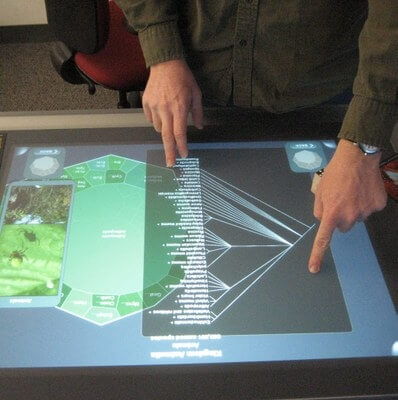News
CONTACT: Caroline Perry at 617-496-1351
CAMBRIDGE, Mass. - October 15, 2010 – A team of Harvard University computer scientists, evolutionary biologists, educational researchers, and museums has received a three-year, $2.3 million National Science Foundation (NSF) grant to fund the development of a multi-touch digital museum exhibit.
Using cutting-edge tabletop computing technology, the researchers plan to develop interactive, cooperative learning activities to educate the public on evolution.
The grant, awarded by the NSF’s Division of Research on Learning in Formal and Informal Settings, provides funding over three years for the development of eight learning activities, of varying levels of difficulty, that will teach the principles of natural selection and common descent. The software package will be made available to any interested museum with the appropriate hardware.
Principal Investigator Chia Shen, a Senior Research Fellow at Harvard’s School of Engineering and Applied Sciences (SEAS), says the project will build on existing multi-touch computing technology, but expand its capabilities in supporting adaptive interfaces for multiple, simultaneous users.
“In informal education settings, people often interact and play together,” says Shen. “The activities will be designed such that they will be collaborative and cooperative, adapting to multiple players’ presence on the same multi-touch tabletop.”
The activities will involve visual and tactile representations of phylogeny—essentially, maps of the branching evolutionary relationships between species—that can be manipulated on a large multi-touch-screen panel.
On a multi-touch table in the Scientists’ Discovery Room (SDR) Lab at SEAS, users can navigate through the Tree of Life, zoom in on a particular clade for more detail, move groups of objects around to reveal new links and relationships, and launch images, sound, and animations that combine to create a fully sensory, interactive experience.
The “Life on Earth” project will take this technology further, designing structured learning activities that are tailored to museum visitors’ varying levels of knowledge, and accommodating, for instance, children’s developmental needs.
For example, one activity could examine basic body plans, while others might delve deeper into anatomy or even DNA and genetics. The researchers also want to target and challenge visitors’ preconceptions about evolution.
“People carry intuitions about what evolution means to them, depending on their culture, religion, and demographic background,” says Shen. “We will design and examine interactive multi-touch activities and games that help people to grasp this scientific concept with their intuition as the starting point. Sometimes, their intuition represents misconception. Through our learning activities, we hope to demonstrate conceptual learning gains.”
One of the challenges the researchers face is the sheer amount of data that needs to be accessible through the activities. Biologists have identified 1.8 million living species on Earth, and mapping the relationships between them all is no easy task.
The “Life on Earth” team must devise algorithms and human-computer interaction techniques that allow multiple users to simultaneously and interactively visualize and manipulate this data.
“Even if we allow only a subset of the data being interacted upon at any time, it will still be a difficult research problem,” says Shen. “Most of today's multi-touch, multi-user systems can only support interactions on simply discrete objects such as photos. A large tree is a continuous graph with huge context (the full tree) and many details (individual species’ nodes and information) to be explored and interacted upon.”
The crowds of visitors that gather around a museum exhibit, coming and going as they please, present another challenge. The software must allow users to join or leave the activity partway through without disrupting others’ play, while still providing a meaningful learning experience.
The “Life on Earth” project will be led by the SDR Lab at SEAS. Partner organizations include the Encyclopedia of Life Learning and Education Group, the University of Nebraska State Museum, the Center for Human Growth and Development at the University of Michigan, Northwestern University Department of Learning Sciences, the California Academy of Sciences, the Field Museum of Natural History, the Boston Children’s Museum, and Harvard Museum of Natural History.
###
Full list of collaborators:
- Chia Shen (PI), Director, Scientists’ Discovery Research Lab, School of Engineering and Applied Sciences, Harvard University
- Judy Diamond (Co-PI), Professor and Curator, University of Nebraska State Museum
- Margaret Evans (Co-PI), Assistant Research Scientist, Center for Human Growth and Development, University of Michigan
- Michael Horn (Senior Personnel), Assistant Professor, Computer Science and Learning Sciences, Northwestern University
- Amy Spiegel (Senior Personnel), Research Associate Professor, Center for Instructional Innovation, University of Nebraska-Lincoln
- Jim Hammerman (External Evaluator), Senior Researcher & Evaluator, TERC
- Harvard Museum of Natural History
- University of Nebraska State Museum
- California Academy of Sciences
- Field Museum of Natural History
- Boston Children’s Museum
###
For more information about the Scientists' Discovery Research Lab, visit http://sdr.seas.harvard.edu/. To view a video of a multi-touch table in action at the SDR Lab, click here.
Cutting-edge science delivered direct to your inbox.
Join the Harvard SEAS mailing list.
